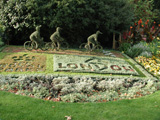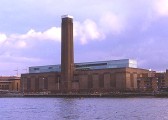Henry Moore at Kew
Originally published in January 2008 in The American in Britain Magazine
Kew Gardens, a 300 acre World Heritage site, provides the perfect setting for twenty-eight of Henry Moore’s large-scale sculptures. Monumental best describes this exhibition. Reputedly the greatest British sculptor of the 20th century, Moore wanted his sculptures to be displayed out-of-doors. Kew’s stunning foliage, lawns, water, architecture together with the changing seasons enhances Moore’s work.
There is an extra-special treat for visitors to Kew Gardens this winter. A landmark open air exhibition, ‘Moore at Kew’, is one of London’s current major attractions. Twenty-eight large-scale sculptures by Henry Moore have been installed in 300 acres of the Royal Botanic Gardens, a World Heritage Site. This is the first and largest outdoor exhibition of Henry Moore’s work in London since the Serpentine Gallery presented his sculptures in 1978. Curators David Mitchinson and Anita Feldman Bennet of the Henry Moore Foundation have selected a combination of pieces that have not been collected together in London before. People can see the sculptures in the round, view them from a distance, and get close enough to feel their surface textures. Kew’s stunning foliage, lawns, water, architecture and glasshouses fuse with winter light to create an atmosphere perfectly suited to display these unique three-dimensional works. “Monumental” best describes this exhibit.
Inspired by natural and organic forms, Yorkshire born Henry Moore (1898-1986), shared a lifelong relationship with nature and the ever-changing landscape. In 1973, he wrote: “I have always been very interested in landscape…..I find that all natural forms are a source of unending interest – tree trunks, the growth of branches from the trunk, each finding its own individual air-space…The whole of nature is an endless demonstration of shape and form. It always surprises me when artists try to escape from this.” (page 15 in catalogue, Moore at Kew)
Far from escaping, Moore invested his creative energy in moulding, carving and casting forms based on the natural habitat, human body and totemic symbols. Endlessly exploring the elemental bond between man and nature, he made small scale models and maquettes adapted from rock formations, animal skulls, bones, fragments of birds and the human figure. He wanted them to be alive -larger than the stone, wood, bronze and fibreglass from which they were carved and cast. Eventually these forms were enlarged. Today many of these massive organic and biomorphic sculptures in Kew’s exhibit are immediately recognisable as Moore’s signature pieces.
You might well ask how these enormous multi-ton works were installed. A glimpse of the images seen here will help to answer the question. Given the size and scale of them, several had to be crane-lifted into the gardens. The ‘Large Reclining Figure’ (1984), the white multi-part fibreglass work, is pictured here. After layers of protective wrapping were removed, this enormous slender two-part feminine sculpture was ‘planted’ on the lawn. She is the first of Moore’s sculptures you meet when you start your tour. Sitting comfortably next to the lake with the Victorian iron-framed glass Palm House in the background, she helps to set the scene for the rest of the exhibition. The siting of this work is perfect. She appears to be resting comfortably, perhaps contemplating the sky. Clearly, her dramatic presence is a striking introduction.
No less effort went into the design and preparation for placing the other twenty-seven sculptures. Once the curators found suitable places, the ground had to be prepared to take the weight. Proper foundations were essential. The ‘Double Oval’ bronze pictured here shows the sculpture just after it was ‘planted’. This dramatic work demonstrates one of Moore’s central themes: the simplicity of organic mass. And when the ice rink was opened in Kew this winter, the ‘Double Oval’ appeared again in the form of an ice sculpture. The contrast between the massive bronze version and the translucent ice sculpture is visually stunning. Pictured here are the duplicate sculptures. Alas, the ice will have melted by the time this article appears. Perhaps some readers may have gone skating at Kew this winter and were delighted to be able to see two ‘Double Ovals’, one in bronze and one in ice.
Core subjects in Henry Moore’s work derive from universal themes: Mother and Child and human forms. He openly admitted to having an obsession with the relationship between Mother and Child throughout his life. It is not surprising, therefore, that Moore’s sculptures of mothers and children and families are amongst his most recognisable and popular works. He began by sketching, scribbling and then moved on to making models in plaster maquettes or carvings. But when his designs were realised as large-scale sculptures, they achieved a different level of expression. They communicate the human experience immediately. It does not matter whether the forms consist of one, two, three or more parts. They can be standing, sitting or reclining. For Moore, openings and outlines and space are all expressive. He wrote, “You leave space for the body, imagining the other part even though it isn’t there.”
Images shown here illustrate Moore’s diverse interpretation and understanding of human and organic forms. His ‘Draped Reclining Mother and Baby’ in bronze (1983) draws our attention to the warmth and natural unity of the relationship between mother and child. Viewers can listen to the audio guide for a discussion of this work. Note, too, the audio guide provides explanations for a number of the sculptures at different locations throughout the gardens. The guide tells us about the ‘Draped Reclining Woman’. She wears cloth in the classical style, reflecting ancient Greek influences in Moore’s work To the left of the ‘Draped Reclining Woman’ see the ‘Large Two Forms’ nestled beneath trees.
Although Moore rarely studied the male form, there are a few notable exceptions. He explored warrior themes and had a keen interest in the armour section at the Wallace Collection. But his personal response to war was more emotional. Perhaps this is explained by his having lived through the two World Wars. His appointment an official war artist during the Second World War gave him the opportunity to record his observations of Londoners in Underground stations and miners in the Yorkshire mines. He produced seventeen large scale drawings displayed in public galleries and museums throughout the UK. Today many can be seen at the Imperial War Museum and the National Gallery. Pictured here is Moore’s bronze ‘Goslar Warrior’, 1974, set in front of a classical sheltered temple. The exhibition catalogue describes this sculpture as “a warrior, with his twisted, thin, fallen body [which has] only one limb, rendering him powerless….underlining his vulnerability and humanity.”
There are many other important works in this comprehensive exhibition of Moore’s sculptures. His Totemic Series known as Motives, with echoes of totem poles of the North America’s indigenous peoples remind us of ancient earthly symbols. His Internal/External pieces are compelling. This is a very ambitious show and I recommend you spend some time in the Nash Conservatory, pictured here, where a case contains the tools Moore used in moulding and carving his models. Finally, during the winter season, the beauty of these sculptures may feel more sombre in Kew’s landscape but they are no less spectacular. Visitors will enjoy them as much now as they will in early spring. Do visit this remarkable exhibition before it closes at the end of March 2008. After that date several of the works will be shipped across the Atlantic where they will be shown at the New York Botanical Gardens from May through November and in the Atlanta Botanical Garden from May 2009 to January 2010.
Further Information:
Kew Gardens Exhibition of Moore at Kew runs through March 2008.
Details of the Exhibition can be found on the Royal Botanic Gardens, Kew website:
www.kewgardens.org and click on More about Henry Moore at Kew…
Remember to listen to the innovative audio guide through your computer and/or while you tour the exhibit. You can hear the curators explain why they chose the sites and also explain the meaning of the sculptures. This is a wonderful resource
Images can be browsed at http://www.kew.org/press/images/index.html. There is a user friendly interactive map of the sculptures together with information about them. But seeing the exhibition with your own eyes is much better!
Contact: Abby Cronin at artsjournalist@abbycronin.co.uk
Website: www.abbycronin.co.uk




